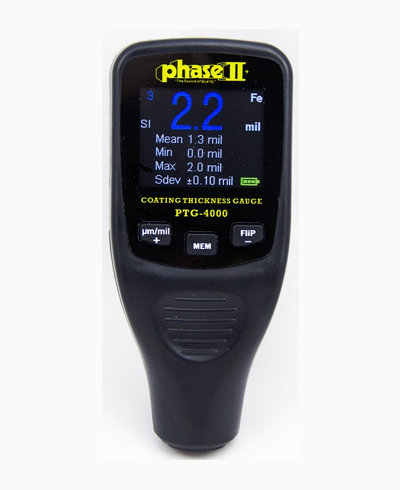Coating Thickness Gauges PTG-4000/Coating Thickness Gages/Paint Thickness Meters/Paint Gauge
The PHASE II PTG-4000 coating thickness gauge can perform two different methods of calculating thickness measurement by utilizing the characteristics of both eddy current and magnetic induction.
Testing performance is both non-destructive and extremely accurate.
With this state of the art coating thickness gage, you can easily detect the thickness of nonmagnetic coating on a magnetic substrate (ferrous) or an insulating coating on a non-magnetic conductive substrate (non-ferrous) utilizing our auto-detect, integrated probe
The PTG-4000 coating thickness gauge can be used in many areas of industry including automotive auctions, manufacturing, general engineering, commercial inspection, etc.
Coating thickness measurement with Color
Flip Display!
The PHASE II PTG-4000 coating thickness gauge can perform two different methods of calculating thickness measurement by utilizing the characteristics of both eddy current and magnetic induction.
Testing performance is both non-destructive and extremely accurate.
With this state of the art coating thickness gage, you can easily detect the thickness of nonmagnetic coating on a magnetic substrate (ferrous) or an insulating coating on a non-magnetic conductive substrate (non-ferrous) utilizing our auto-detect, integrated probe
The PTG-4000 coating thickness gauge can be used in many areas of industry including automotive auctions, manufacturing, general engineering, commercial inspection, etc.
Main Technical Data
- Measuring range: 0-1,250 µm max. or 0-50 mils
- Resolution: 1 µm / 0.1mils
- Accuracy: +/- 3% + 2 µm ( +/-3%+0.1 mil )
- Display: 3 digit color LCD
- Statistics: Min/Max, Average, Std Deviation
- Single or Continuous Measurement(Selectable)
- Min. measuring area: 0.2″ x 0.2″ (5mm x 5mm)
- Min. radius of curvature: Convex: 0.12″ (3mm) Concave: 1.2″ (30mm)
- Min. substrate thickness: Ferrous: 20 mils (0.5mm) Non-ferrous: 2 mils (50 µm)
- Max. Surface temperature of test object: 302 degrees F (contact time max is 2 seconds)
- Power source: 2-AAA batteries
- Dimensions: 100 x 52 x 29mm
- Weight: 2.4oz. (w/o Batteries)
The PTG-4000 coating thickness gauge utilizes an integrated probe that can automatically detect a Ferrous or Non-Ferrous substrate and comes with 2 substrate samples(steel,aluminum), 4 calibrated thickness samples, carry case, batteries and operation manual.
Non-Destructive Coating Thickness Measuring Principles
1) Magnetic Induction Priciple:
The Phase II PTG series of Coating Thickness Gages utilize this non-destructive priciple when measuring coatings on ferro-magnetic substrates such as Steel and Iron. The coatings must be non-magnetic such as; paint, enamel, aluminum, chrome, copper and brass.
2) Eddy-Current Priciple:
The Phase II PTG series of Coating Thickness Gages utilize this non-destructive priciple when measuring coatings on non-magnetic substrates such as; Aluminum, Aluminum Alloys, bronze, copper, brass tin and rustproof weak magnetic steels. The coatings must be electrically insulating such as; paint, enamel, plastics, anodized coatings and ceramics.
Calibration Procedures
NOTE: All PTG series Coating Thickness Gages are inspected and calibrated using the Two-Point Calibratiuon procedure prior to shipment.
1) One-Point Calibration:
This procedure is accomplished by “Zeroing” the gage on an uncoated version of the sample that you will be checking the coating thickness on. To accomplish this calibration, you will need to follow the simple calibration procedure that is explained in the operation manual. Although this is an accurate method for calibration, it is not as accurate as using the two point calibration.
2) Two-Point Calibration:
This procedure is accomplished by “zeroing” the gage on one of the supplied substrate samples (steel/aluminum) and then placing one of the calibrated “foils” on that substrate and calibrating the gage to match the known thickness of the foils. It is best to use the foil that is closest to the actual known thickness of your own samples to be tested. This is a very simple procedure that is explained in the operation manual. By using the two-point calibration procedure, you are making sure that the gage will be at its most accurate when testing your own coated samples. This is the same method used to calibrate every gage prior to shipment.
3) Frequency of Calibration:
Once the PTG series of Coating Thickness Gages have been calibrated, the parameters are saved in the memory and the calibration procedure does not need to be repeated.
We do recommed that after numerous hours of operation or if the gage has not been used for a few days you should check the accuracy using the same calibrated substrate/foil combination previously used to calibrate the gage.


